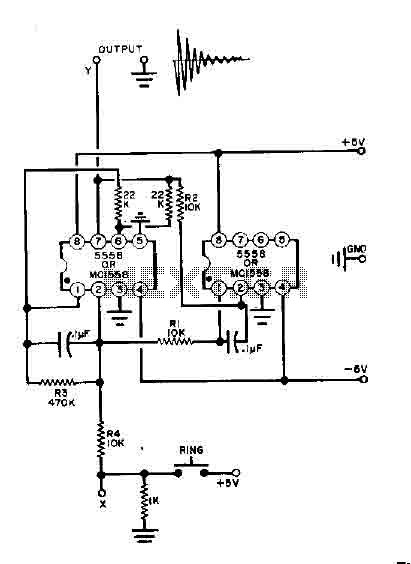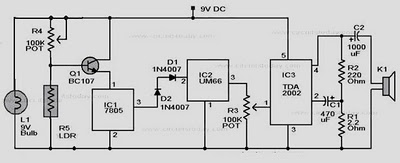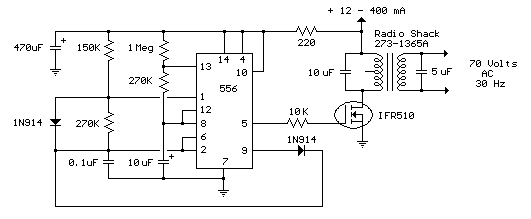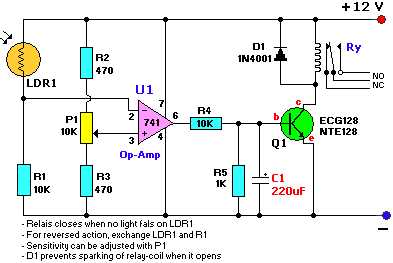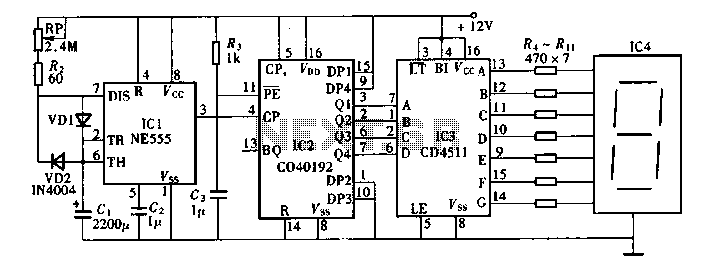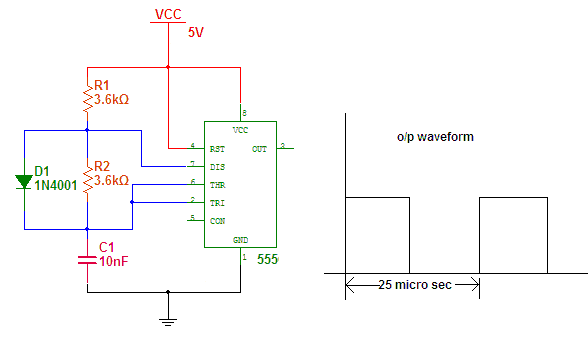
fm generation using 555 timer

The difference between instantaneous frequency and central frequency of the carrier is directly proportional to the instantaneous value of the amplitude of the message signal. A 555 Timer configured in Astable Mode can be utilized for generating Frequency Modulated (FM) waves. In an astable multivibrator, the 5th (Control Voltage) pin of the 555 timer is typically not used; however, in this application, the message signal is applied to this pin, resulting in frequency variation. The 8th and 1st pins of the 555 timer are connected to the power supply (Vcc) and ground (GND), respectively. The 4th pin serves as the Reset pin, which is an active low input and is connected to Vcc. When the output is high, capacitor C1 charges to Vcc through resistor R1 and diode D. Conversely, when the output is low, the capacitor discharges through resistor R2 and the 7th pin of the IC. The charging and discharging time periods determine the output time period. The message signal is coupled to the 5th (Control Voltage) pin through a capacitor, and the output is taken from the 3rd pin of the IC. The central frequency or carrier frequency of the generated FM can be calculated using the formula fo = 1/(0.693RC), where R = R1 = R2 and C = C1. When an input voltage (V) is applied to the Control Voltage pin, the reference voltages for the upper and lower comparators change to V and V/2, respectively. When the capacitor voltage drops below V/2, the output goes high, and the capacitor begins charging to Vcc through resistor R1 and diode D. When the capacitor voltage exceeds V, the output goes low, and the capacitor discharges through resistor R2 and the 7th pin of the IC. Thus, the output time period is proportional to the input voltage V; as V increases, the output wave time period increases, and as V decreases, the output wave time period decreases.
The described circuit utilizes a 555 timer in astable mode for the generation of frequency-modulated (FM) signals. The operational principle hinges upon the modulation of the control voltage pin, which influences the timing characteristics of the output waveform.
In this configuration, the 555 timer operates by alternately charging and discharging capacitor C1, with the timing determined by resistors R1 and R2. The frequency of the output signal is primarily dictated by the values of these resistors and the capacitor according to the formula fo = 1/(0.693RC). The introduction of the message signal at the control voltage pin modifies the reference levels for the internal comparators of the 555 timer, allowing for dynamic adjustments in the output frequency in response to changes in the amplitude of the input signal.
The circuit's design ensures that when the voltage at the control pin increases, it raises the threshold for the upper comparator, leading to a longer charging cycle for capacitor C1. Conversely, when the control voltage decreases, the time taken to discharge the capacitor is reduced, resulting in a higher frequency output. This modulation process effectively encodes the message signal onto the carrier wave, producing a frequency-modulated signal suitable for various communication applications.
The implementation of diodes and capacitors in conjunction with the 555 timer ensures that the circuit maintains stability and minimizes distortion, which is critical for preserving the integrity of the modulated signal. The careful selection of resistor and capacitor values allows for a wide range of frequency outputs, making this circuit versatile for different modulation requirements. Overall, the application of the 555 timer in this manner illustrates a practical approach to generating FM signals, leveraging its simplicity and reliability in electronic design.The difference between instantaneous frequency and central frequency of the carrier will be directly proportional to the instantaneous value of the amplitude of message signal. 555 Timer wired in Astable Mode can be used for generating Frequency Modulated (FM) waves. Please read the article Astable Multivibrator using 555 Timer for more details about the circuit. In astable multivibrator we don`t use the 5th (Control Voltage) pin of 555 but here we fed the message signal to this pin which results in the variation of frequency. 8th and 1st pin of the 555 are used for giving power, Vcc and GND respectively. 4th pin is the Reset pin which is a active low input, since it is tied to Vcc. When the output is high, capacitor C1 charges to Vcc through R1 and D. When the output is low, capacitor discharges through resistor R2 and 7th of the IC. This charging and discharging time periods determines the time period of output. Message signal is fed to 5th (Control Voltage) pin of the IC through a coupling capacitor and the output can be taken from the 3ed pin of the IC.
I hope that you read the working of Astable Multivibrator using 555 Timer. Central frequency or Carrier frequency of the generated FM can be determined from the expression, fo = 1/(0. 693RC), where R = R1 = R2 and C = C1. When an input voltage (say V) is given to Control Voltage pin, the upper and lower comparator reference changes to voltages V and V/2.
So when the capacitor voltage becomes less than V/2, output becomes high and the capacitor starts charging to Vcc through resistor R1 and diode D. When the the capacitor voltage becomes greater than V, output becomes low and the capacitor starts discharging through resistor R2 and 7th pin of the IC.
So the time period isproportionalto the input voltage V. So as V increases, time period of the output wave increases and when V decreases time period of the output wave decreases. 🔗 External reference
The described circuit utilizes a 555 timer in astable mode for the generation of frequency-modulated (FM) signals. The operational principle hinges upon the modulation of the control voltage pin, which influences the timing characteristics of the output waveform.
In this configuration, the 555 timer operates by alternately charging and discharging capacitor C1, with the timing determined by resistors R1 and R2. The frequency of the output signal is primarily dictated by the values of these resistors and the capacitor according to the formula fo = 1/(0.693RC). The introduction of the message signal at the control voltage pin modifies the reference levels for the internal comparators of the 555 timer, allowing for dynamic adjustments in the output frequency in response to changes in the amplitude of the input signal.
The circuit's design ensures that when the voltage at the control pin increases, it raises the threshold for the upper comparator, leading to a longer charging cycle for capacitor C1. Conversely, when the control voltage decreases, the time taken to discharge the capacitor is reduced, resulting in a higher frequency output. This modulation process effectively encodes the message signal onto the carrier wave, producing a frequency-modulated signal suitable for various communication applications.
The implementation of diodes and capacitors in conjunction with the 555 timer ensures that the circuit maintains stability and minimizes distortion, which is critical for preserving the integrity of the modulated signal. The careful selection of resistor and capacitor values allows for a wide range of frequency outputs, making this circuit versatile for different modulation requirements. Overall, the application of the 555 timer in this manner illustrates a practical approach to generating FM signals, leveraging its simplicity and reliability in electronic design.The difference between instantaneous frequency and central frequency of the carrier will be directly proportional to the instantaneous value of the amplitude of message signal. 555 Timer wired in Astable Mode can be used for generating Frequency Modulated (FM) waves. Please read the article Astable Multivibrator using 555 Timer for more details about the circuit. In astable multivibrator we don`t use the 5th (Control Voltage) pin of 555 but here we fed the message signal to this pin which results in the variation of frequency. 8th and 1st pin of the 555 are used for giving power, Vcc and GND respectively. 4th pin is the Reset pin which is a active low input, since it is tied to Vcc. When the output is high, capacitor C1 charges to Vcc through R1 and D. When the output is low, capacitor discharges through resistor R2 and 7th of the IC. This charging and discharging time periods determines the time period of output. Message signal is fed to 5th (Control Voltage) pin of the IC through a coupling capacitor and the output can be taken from the 3ed pin of the IC.
I hope that you read the working of Astable Multivibrator using 555 Timer. Central frequency or Carrier frequency of the generated FM can be determined from the expression, fo = 1/(0. 693RC), where R = R1 = R2 and C = C1. When an input voltage (say V) is given to Control Voltage pin, the upper and lower comparator reference changes to voltages V and V/2.
So when the capacitor voltage becomes less than V/2, output becomes high and the capacitor starts charging to Vcc through resistor R1 and diode D. When the the capacitor voltage becomes greater than V, output becomes low and the capacitor starts discharging through resistor R2 and 7th pin of the IC.
So the time period isproportionalto the input voltage V. So as V increases, time period of the output wave increases and when V decreases time period of the output wave decreases. 🔗 External reference
